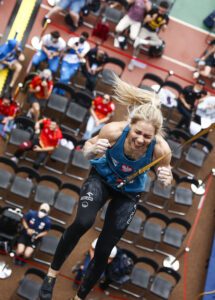What is the Limit? Katibin Sets New Speed World Record
Kiromal Katibin sets his fourth consecutive world record. What is the limit on these Speeders' abilities?

Speed Climbing is progressing faster than all other sprint-based sports. Today, Indonesia’s Kiromal Katibin set his fourth consecutive World Record this year. In total, Katibin has set five World Records since May 28 of 2021. Unlike female record holder Aleksandra Miroslaw, many in Katibin’s category are within range of the record holder. What does this mean for the direction of Speed climbing?

Six Speed World Records in 13 Months
The difference between today’s record setting pace of 5.04 seconds the 5.20 World Record time Veddriq Leonardo is simple to describe: one year’s worth of effort. Without a doubt, Katibin is gifted, but he has improved by over .21 seconds in the last 13 months. That is more than genius. That is the result of being the best of the field in a sport that has not reached its ceiling. It is the result of training.
Katibin’s first world record, one year ago, was 5.25 seconds. America’s John Brosler set that US National record last month with a 5.20 time. Today, two Chinese athletes, brand new to the World Cup circuit each set 5.21 and 5.22.
Their names are Cao Long and Lon Jianguo. Their teammate Wu Peng snapped up fourth in qualifiers with a quick 5.32. The difference between the world’s best Speed climbers is shrinking as the entire field is approaches the sub 5-second mark. Katibin may even pass the mark today in Finals.
Speed Climbing Versus The 100-Metre Dash
The pace with which the World Record has improved is nearly unprecedented in modern sport. Even within climbing, the recent increase in Speed is almost unbelievable. The same 15-metre sport route has persisted since 2011.

In 2011, China’s Qixin Zhong ran a 6.26. In 11 years, this record was reset 11 times. Six of those times took place in the last 13 months. Since 2011, the Speed World Record dropped by 20%.
In the much older sport of running, World Records are rare and by slim margins. By comparison, Usain Bolt’s 100-metre record has stood for 12 years and 9 months. Since 1964, the 100-metre world record dropped from 10.06 to Bolt’s 9.58. Bolt pushed the sport dramatically, cutting an incredible .16 seconds off Asafa Powell’s previous record. Still, since 1964, the 100-metre times have dropped by less than 5%.
As such, what does this difference mean for Speed Climbing? If over nearly 60 years, the 100-metre can drop 5% for .5 seconds, how long will it take for Speed Climbing to hit its slow-growth threshold?
At the moment, Katibin is driving the record down with only greater pace as the rest of the field pressures the Indonesian Speeder’s record-holding position. It is difficult to map Speed’s progression onto other sports because other sports have not seen this level of progression in modern history. Even if we extend our 100-metre reach to 1891, we still end up with a fairly quick 10.8 second sprint from America’s Luther Cary. Even though Cary’s time took place over 130 years ago, the time drops by less than 12%.

What’s more, this same translation can be found in the women’s category. From 2013 to 2022, the record has been reset 14 times in the women’s category. Today, Poland’s Aleksandra Miroslaw approaches Zhong’s record with her pace of 6.53 seconds. Miroslaw has also reset the World record several times this year, with three record breaking runs since August.
Since 2013, the women’s world record pace dropped from 7.85 second to 6.53 seconds, or by about 16.8%. Like the men’s category, 100-metre athletes cannot match the progression of female Speeders over a similar nine year stretch.
With that said, the last century of women’s 100-metre may closely reflect the progression we can expect from the men’s and women’s Speed categories. In August of 1922, Marie Mejzlíková II ran a 13.6 100-metre. By 1988, Florence Griffith-Joyner ran the current world record time of 10.49. This increase in pace dropped the record by over 22%.
Although the 100-metre sprint is an old sport, women’s involvement in the discipline is relatively new. It was only in the 1920s that women started having more access to sport in the west. As such, their progression may be something we compare to Speed Climbing in both the men’s and women’s categories. In both cases, high-level competition began among populations without much experience in the discipline in which they were competing.

Approaching the Limit
This is interesting when we look at Griffith-Joyner’s run. The women’s world record did not move after her sprint in 1988. Griffith-Joyner outpaced the previous record holder by an unbelievable .27 seconds. This is the sort of progression we have seen from Speed Climbing’s Miroslaw as well.
Since Iuliia Kaplina’s previous World record in 2020, Miroslaw dropped the time by 0.43 seconds. Between August and May of this last year, Miroslaw beat her own record by an incredible .2 seconds. What is interesting about the Women’s Speed World Record compared to the Women’s 100-metre sprint, is that Miroslaw has not shown signs of slowing.
If we can compare the two sports, Miroslaw may set a record in the coming year that no one can surpass.
In the men’s category, if we are to transfer what we have learned from the women’s category, then we may already be upon the threshold of near-max speed. With that said, Speed Climbing is a wildly more technical sport than sprinting, and it allows for developments such as the Tomoa Skip, a move that cuts away time from the ascent of the route. As such, a direct comparison is not possible.
Given the current rate of progression in both the men’s and women’s fields, a category-wide plateau seems unlikely, but if that is the case, then where will Speeders find the limits of their abilities?
If we can presume a 22% growth before a hard plateau, then the men’s field is on track to hit around 4.88 before struggling to push further. In the women’s field, it would seem that the threshold is around 6.123 seconds.
In the meantime, Speed Finals begins in Villars at 9:00pm (UTC+2:00).
Men Advancing to Finals
1 – Kiromal Katibin (INA)
2 – Long Cao (CHN)
3 – Jianguo Long (CHN)
4 – Peng Wun (CHN)
5 – Reza Alipour Shenazandifard (IRI)
6 – John Brosler (USA)
7 – Jinbao Long (CHN)
8 – Veddriq Leonardo (INA)
9 – Alfian Muhammad Fajri (INA)
10 – Rahmad Adi Mulyono (INA)
11 – Ludovico Fossali (ITA)
12 – Guillame Moro (FRA)
13 – Erik Noya Cardona (ESP)
14 – Marcin Dzienski (POL)
15 – Zaenal Aripin (INA)
16 – Samuel Watson (USA)
Women Advancing to Finals
1 – Di Niu (CHN)
2 – Lijuan Deng (CHN)
3 – Aleksandra Kalucka (POL)
4 – Desak Made Rita Kusuma Dewi (INA)
5 – Rajiah Sallsabillah (INA)
6 – Emma Hunt (USA)
7 – Aurelia Sarisson (FRA)
8 – Natalia Kalucka (POL)
9 – Shengyan Wang (CHN)
10 – Capucine Viglione (FRA)
11 – Patrycja Chudziak (POL)
12 – Nurul Iqamah (INA)
13 – Andrea Rojas (ECU)
14 – Anna Brozek (POL)
15 – Franziska Ritter (GER)
16 – Beatrice Colli (ITA)
Featured image of Kiromal Katibin at Seoul by Dimitris Tosidis.


